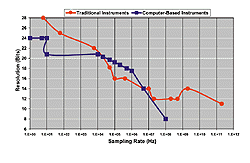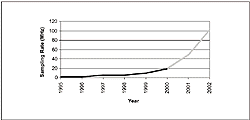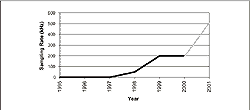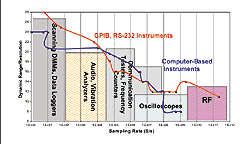
June, 2000
James Kimery, National Instrumenst
Measurement technology has evolved continually in recent years, and is now poised for a new level of growth in the form of digital measurement systems. Such systems go beyond advances to digital or virtual instruments; they are modular solutions composed of elements from various fronts, including not only instrumentation, but software, control, and so forth.
Let’s review the development of measurement technologies and explore some of the components—such as ADCs and microprocessors—that make possible the next evolutionary step and how they have changed the landscape for end users.
From Analog to Digital
Early instruments were built with discrete analog and mechanical components. For example, early meters used a coil and a needle. The needle traveled across a graded scale on the instrument’s face to indicate a measurement reading in proportion to the magnitude of the applied stimulus. In an analog instrument, the acquisition of the signal merges with and is part of the presentation so the measurement can be taken directly from the display.
The introduction of digital technology to instruments was a significant step for the industry. Instead of discrete analog and mechanical components, digital instruments use analog-to-digital converters (ADCs) to digitize analog signals into a numerical representation. The data acquired are stored in memory within the instrument, and can be presented on the instrument display (as an analog instrument) or processed and analyzed.
By embedding microprocessors in instruments, vendors were able to create new features with custom software: signal processing, mathematical operations, communication interfacing, and/or configuration enhancements such as autosetup. Stand-alone digital instruments or digitizers essentially became computers with built-in ADCs.
The virtual instrumentation paradigm, pioneered in the 1980s, demonstrates that acquisition, analysis, and presentation need not reside in the same box, but can be distributed between the instrument (in stand-alone, modular, or PC plug-in board form factor) and the system computer.
The Ever-Evolving ADC
The proliferation of digital instruments sparked the renaissance of the ADC. Today, there are several types of ADCs that vary widely in resolution, sampling rate, and speed (see Table 1). Instruments deploy the ADC best suited to their designated function and the type of measurements defined by the manufacturer.
Since the birth of digital instruments, stand-alone instrument manufacturers have developed custom ADC technology to provide products with unique and differentiated measurement capabilities. By contrast, computer-based instrument and data acquisition board manufacturers developing PXI/CompactPCI modules and/or PCI plug-in boards typically use off-the-shelf ADCs. Figure 1 plots the ADCs used by both types of instruments. In the past there was a large gap between them; but innovations are narrowing this gap, and currently the biggest differences appear at the extremes of the graph where cost-effective off-the-shelf ADCs have yet to emerge.
TABLE 1 : ADC Comparison
Type of ADC
Typical Application Sampling Rate
Resolution
Successive approximation Data acquisition
5MHz
<16 bits
Integrating
DMMs
1kHz
>20 bits
Flash
Oscilloscopes
1 GHz
8 to 10 bits
Delta-Sigma
Frequency analyzers
192 kHz
<18 bits
Two key market forces drive innovation in ADCs. First,
semiconductor
manufacturers armed with new process technologies can now produce
high-performance ADCs cost effectively. Second,
large investments by telecom and consumer electronics companies
motivate semiconductor manufacturers to deliver these new and breakthrough
ADC technologies.
Driven by growing business and consumer demand for higher bandwidth
communications, the telecom industry needs faster flash ADCs (see
Figure
2). Multimedia companies invest in high-precision delta-sigma
converters to meet the growing demands of digital audio/video market for
products such as DVD players, DTV equipment, and HDTV (see Figure 3).
Note that the line past 1999 in Figures 2 and 3 denotes forecasted
projections, and some commercial off-the-shelf ADCs available have
been omitted because their cost made them infeasible for most applications.
Of Digitizers and Instruments
Taking a digitizer view of the instrumentation world, stand-alone instruments can be compared across a continuum of sampling rate and resolution—the properties of the ADC technology they use (see Figure 4). DMMs and data loggers, which employ high precision ADCs, occupy the left side of the graph—low sampling rates but high resolution. The far right section is reserved for spectrum, network, and vector-network analyzers that need the highest sampling rates for measuring RF signals.

Figure 1. This graph compares the digitizing capabilities
of stand-alone vs. computer-based instruments.

Figure 2. The sampling rate of 12 bit ADC technology for telecommunications applications is expected to rise steadily in the next couple of years.

Figure 3. The sampling rate for 24 bit ADCs used in consumer electronics has leveled off recently but is ready to spike.

Figure 4. Here you can see typical instruments —both stand-alone and computer-based—plotted by ADC capability.
Stand-Alone Instrument Trends
With the ADC gap between stand-alone and computer-based instruments narrowing, stand-alone instrument vendors must differentiate their products in other ways. Traditional basic instruments such as DMMs, oscilloscopes, and function generators cover common measurement ground (except for the extremes found at the high end of the scale) within each class. For more common measurements below the extremes, stand-alone instrument vendors add other differentiating features. Rather than lowering prices, in many cases instrument vendors keep prices constant and justify them with added features. End users pay for these features whether they need them or not.
Another way to differentiate products is to solve specific applications. To capitalize on opportunities in vertical markets (as in telecommunications and semiconductor industries, which demand new capabilities for their continually changing environments), some vendors are developing instruments that take a set of measurements for a targeted market. Although the digitizer technology used in these instruments may be the same as that for a standard product, they often include custom embedded software. Application specific instruments make it easy to solve particular test challenges, but these instruments are typically expensive because volumes are small.
The PC in the Instrument, or the Instrument in the PC?
Stand-alone instrument vendors are also integrating more of the PC and its capabilities to differentiate their products, effectively turning their instruments into PCs. What used to be closed box running a real-time or proprietary operating system has now become a PC, or a PC inside the box. By putting the PC inside the box, the instrument vendor can deliver some of the benefits of the PC, but the customer usually ends up paying a price.
Alternatively, by placing the instrument inside the PC, users have more complete control over the PC, the application software, and the instruments they can create. Moreover, as technology evolves, end users can immediately take advantage of an advancement rather than waiting for the instrument vendor to offer it—with or without additional charge. For instance, if a new networking technology is developed, an end user can simply purchase a new network interface card such as gigabit Ethernet, install it in the PC, and improve the connectivity of the measurement system. As PCs continue to escalate in performance, end users can simply buy a new PC—complete with the latest technology—and reuse the meas urement hardware and software to increase the performance of the entire system.
Using virtual instrument architecture employed by digital measurement systems, users can choose lower cost hardware with raw acquisition or stimulus capabilities and build the rest in software. With the continued evolution in ADC technology, computer-based instruments and data acquisition boards continue to rival stand-alone instruments in the range of measurements possible. Because digital measurement systems completely leverage the trends in ADC technology as well as PC technology, component cost of the measurement system continues to decrease. Not only can customers save money by not paying for unnecessary features, but they can also enhance these lower cost components with software to construct virtual instruments with unique capabilities.
Digital Measurement Systems
Digital measurement systems are more than just collections of instruments. Components of such systems include computer-based instruments and data acquisition boards, but also signal conditioning to add attenuation, filtering, and additional gain for low-level voltage meas urements. End users can also add image acquisition and motion control without having to purchase separate stand-alone systems. High-speed connectivity technologies mean that end users can distribute the elements of the measurement—acquisition, analysis, and presentation—to one or more computers across a network. The components that make up the digital measurement system are tightly integrated using a modular, but unified software architecture.
The Next Step
PCs have realized performance gains of more than 1000% in the last 10 years—why haven’t measurement systems? The answer is that the test and measurement industry is evolving. Just as digital instruments evolved from their analog predecessors, digital instruments will also evolve to virtual instruments. The next step in virtual instrumentation—digital measurement systems—combines the benefits of innovation from different technological fronts. The result: a systems approach in which modular hardware and software components can be added easily to create low-cost, yet powerful systems that can solve today’s test and measurement challenges.
James Kimery is Test and Measurement Strategic Marketing Manager, National Instruments
Sensors® is a registered trademark belonging to Advanstar Communications Inc.